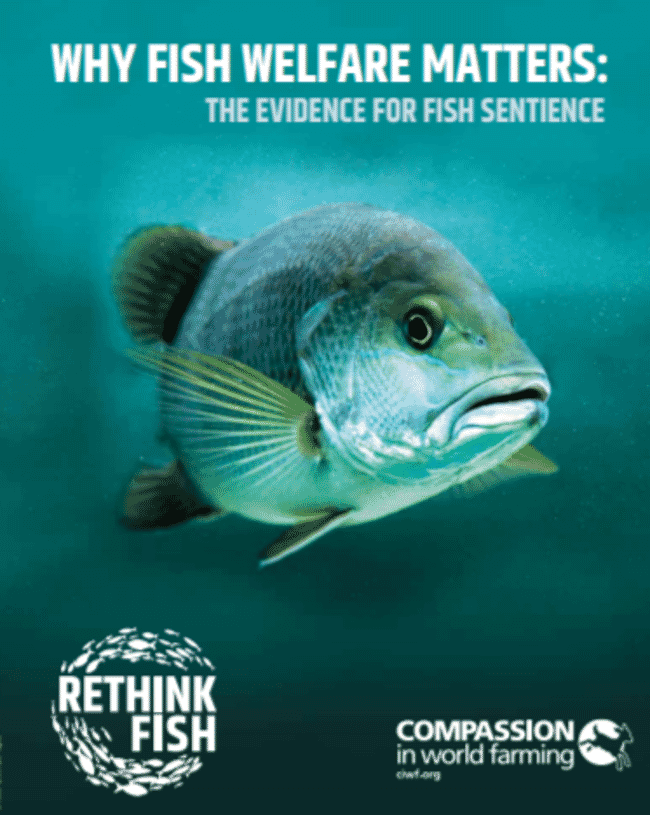
© Compassion in World Farming
What sort of response have you had to the Rethink Fish campaign from both the public and the aquaculture certification providers?
The overall response from the public to this campaign has been positive and supportive – the public are engaged and recognise the need for stronger welfare standards for fish. People are now more aware of fish sentience and want products that come from better welfare conditions.
We are having ongoing open communications with all the aquaculture certification schemes and will continue to develop our relations with them, and assist them at all stages of improving their standards.
Can you give some sense of the scale of global aquaculture?
Around 53 million tonnes of fish were farmed worldwide in 2017, which equates to somewhere between 51 and 167 billion individuals. For comparison, globally over 60.7 billion land animals (including all chickens, cattle, ducks, goats, pigs, rabbits, sheep) are killed each year.
What are the most pressing aquaculture sectors to address?
The biggest aquaculture producer is China, where the biggest production is various species of carp and tilapia. In China every year, over 26 million tonnes of fish are produced, which is estimated at somewhere between 23-76 billion individual fish.
In 2017, Europe produced 731,591 tonnes, and the top producing countries are Spain – which provided just over one fifth of the total (23.0 percent), followed by the United Kingdom (16.3 percent), France (13.8 percent), Italy (11.4 percent) and Greece (9.2 percent).
Atlantic salmon, rainbow trout, gilthead sea bream, European sea bass and common carp are the top five fish species produced. Each of the sectors has its challenges when it comes to animal welfare and environmental impact, but fish welfare is rarely considered in legislation or even industry standards. Things like slaughter without stunning are widespread across the sector.
There are also huge welfare and environmental issues associated with salmon farming, which must be addressed. For example, the Scottish salmon industry has an uncontrollable sea lice infestation problem, and reports of high mortalities; in 2019 there was a 14 percent mortality rate for the Scottish salmon industry. Additionally, there are environmental impacts from the release of various chemicals from farms, farmed fish escapes and diseases and parasites from farms heavily contributing to the decline of wild salmon populations.

© Compassion in World Farming
Which parts of the production process most urgently need to be addressed?
Slaughter
The slaughter process urgently needs to be improved. Most farmed fish around the world are killed using inhumane methods, suffering for prolonged periods as stunning systems are usually not used.
Fish are killed by suffocation in air, or ice water slurry or using carbon dioxide in water. They may also be killed by the gutting and processing itself. These methods involve pain, fear and suffering that can last many minutes and, sometimes, even hours. Pre-slaughter procedures such as fasting, crowding and transport are also significant sources of stress and must be well managed to minimise suffering.
Humane slaughter methods would typically consist of percussive or electrical stunning that ensures consciousness is not recovered before or during slaughter.
Humane slaughter is also an important factor that should be addressed by certification schemes. We would like certification schemes to require humane slaughter on a mandatory basis, for all the fish they certify.
Fishmeal and fish oil (FMFO)
Although the industry calls aquaculture the blue revolution, fish farming is responsible for much of the industrial fishing of our endangered oceans.
Many widely farmed species such as trout, salmon sea bass and sea bream are carnivorous and, in the wild, they hunt other fish. When farmed, these animals are fed fish feed that is made of wild-caught fish.
Approximately one quarter of all wild-caught fish are used to make fishmeal and oil. This comprises of somewhere between 450 billion and 1 trillion individual fish. To make matters worse, the wild-caught fish are not ensured humane slaughter, meaning that there is an additional welfare cost in the production of fishmeal and fish oil.
Since 90 percent of the fish used for FMFO are food-grade fish that could be directly eaten by humans, and around 70 percent of the protein is lost during the conversion from feed to farmed fish product, fishmeal and fish oil are also inherently unsustainable.
What do you think about the rise of “mechanical” sea lice removal methods – such as freshwater and warmwater treatments – in the salmon farming sector?
Unfortunately, many of the mechanical, “environmentally-friendly” sea lice treatments, such as the thermolicer, cause pain and suffering for farmed fish. It is unacceptable to put fish through such a stressful procedure, with risks of mass mortalities.
Also, this is not a permanent way to relieve fish of lice, and so fish may endure this process on multiple occasions. Although sea lice infestations are a welfare problem that needs a solution, that must come in a welfare-friendly form.
Why do you think fish welfare hasn’t been prioritised by many of the established certification schemes?
Fish welfare has long been ignored in society, and historically, people have denied that fish feel pain or that they have emotions. In fish farming, the consideration of fish welfare is usually limited to the promotion of physical health and how it compliments productivity. The mental and behavioural needs of fish are given much less attention despite being essential components of animal welfare. The lack of welfare requirements by certification schemes reflects this.
Additionally, there is very little legislation protecting fish welfare. The World Organisation for Animal Health (OIE) has published guidelines, and there are various national guidelines, but they are not mandatory and not enough is being done to encourage producers to follow them. This is where certification schemes could take an important role in improving fish welfare.
Do you think the Scottish salmon sector’s welfare record is compatible with its extensive RSPCA-assured certification?
Many Scottish salmon are certified by the RSPCA Assured label. Labels that specialise in animal welfare, like RSPCA Assured, do ensure certain minimum standards of welfare for farmed fish – in general, their slaughter methods are more humane, and fish are given more space in their cages and nets. Consumers can turn to this label knowing that they certify fish to higher welfare standards than non-labelled fish. However, the RSPCA Assured scheme does not fully ensure good welfare throughout the lives of the fish and has areas that we feel could be improved.
Additionally, RSPCA Assured does not actively address the issue of farmed fish being fed a diet of wild-caught fish that get ground up into fish meal and oil. This could be done by requiring a certain percentage of fishmeal and fish oil (FMFO) coming from fish trimmings or encouraging alternatives to FMFO.
If you are successful with this campaign, will you turn your attention to species such as shrimp?
The focus of Rethink Fish and the fish certification schemes campaign is fish welfare, but we will seek welfare improvements for other aquatic animals, such as shrimp and octopus, when opportunities arise.


